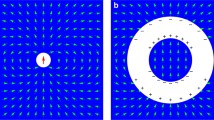Abstract
Common water ice (ice Ih) is an unusual solid—the oxygen atoms form a periodic structure but the hydrogen atoms are highly disordered due to there being two inequivalent O–H bond lengths1. Pauling showed that the presence of these two bond lengths leads to a macroscopic degeneracy of possible ground states2,3, such that the system has finite entropy as the temperature tends towards zero. The dynamics associated with this degeneracy are experimentally inaccessible, however, as ice melts and the hydrogen dynamics cannot be studied independently of oxygen motion4. An analogous system5 in which this degeneracy can be studied is a magnet with the pyrochlore structure—termed ‘spin ice’—where spin orientation plays a similar role to that of the hydrogen position in ice Ih. Here we present specific-heat data forone such system, Dy2Ti2O7, from which we infer a total spinentropy of 0.67R ln2. This is similar to the value, 0.71R ln2, determined for ice Ih, so confirming the validity of the correspondence. We also find, through application of a magnetic field, behaviour not accessible in water ice—restoration of much of the ground-state entropy and new transitions involving transverse spin degrees of freedom.



Similar content being viewed by others
References
Bernal, J. D. & Fowler, R. H. Atheory of water and ionic solution, with particular reference to hydrogen and hydroxyl ions. J. Chem. Phys. 1, 515–548 ( 1933).
Pauling, L. The Nature of the Chemical Bond 301–304 (Cornell Univ. Press, Ithaca, New York, (1945).
Giauque, W. F. & Stout, J. W. The entropy of water and the third law of thermodynamics. The heat capacity of ice from 15 to 273K. J. Am. Chem. Soc. 58, 1144–1150 (1936).
Hobbs, P. V. Ice Physics (Clarendon, Oxford, (1974).
Harris, M. J., Bramwell, S. T., McMorrow, D. F., Zeiske, T. & Godfrey, K. W. Geometrical frustration in the ferromagnetic pyrochlore Ho2Ti2O7. Phys. Rev. Lett. 79, 2554–2557 (1997).
Ramirez, A. P. Geometrical frustration in magnetism. Annu. Rev. Mater. Sci. 24, 453–480 (1994).
Wannier, G. H. Antiferromagnetism. The triangular Ising net. Phys. Rev. 79, 357–364 (1950).
Moessner, R. & Chalker, J. T. Low-temperature properties of classical geometrically frustrated antiferromagnets. Phys. Rev. B 58, 12049–12062 ( 1998).
Schiffer, P. & Ramirez, A. P. Recent experimental progress in the study of geometrical magnetic frustration. Comments Cond. Mat. Phys. 18, 21–50 ( 1996).
Greedan, J. E., Sato, M., Yan, X. & Razavi, F. S. Spin-glass-like behavior in Y2Mo2O7, a concentrated, crystalline, system with negligible apparent disorder. Solid State Commun. 59, 895–897 (1986).
Blöte, H. W. J., Wielinga, R. F. & Huiskamp, W. J. Heat-capacity measurements on rare-earth double oxides R2M2O7. Physica 43 , 549–568 (1969).
Tajima, Y., Matsuo, T. & Suga, H. Phase transition in KOH-doped hexagonal ice. Nature 299, 810–812 ( 1982).
Schiffer, P., Ramirez, A. P., Huse, D. A. & Valentino, A. J. Investigation of the field induced antiferromagnetic phase transition in the frustrated magnet: gadolinium gallium garnet. Phys. Rev. Lett. 73, 2500–2503 ( 1994).
Hov, S., Bratsberg, H. & Skjeltorp, A. T. Magnetic phase diagram of gadolinium gallium garnet. J.Magn. Magn. Mater. 15–18, 455– 456 (1980).
Manaka, H., Yamada, I., Honda, Z., Katori, H. A. & Katsumata, K. Field-induced magnetic long-range order in the ferromagnetic-antiferromagnetic alternating heisenberg chain system (CH3)2CHNH 3CuCl3observed by specific heat measurements. J. Phys. Soc. Jpn 67, 3913–3917 (1998).
Harris, M. J., Bramwell, S. T., Holdsworth, P. C. W. & Champion, J. D. M. Liquid-gas critical behavior in a frustrated pyrochlore ferromagnet. Phys. Rev. Lett. 81, 4496–4499 (1998).
Acknowledgements
We thank C. Ulrich for assistance, and C. Broholm, P. Chandra, A. P. Mills, R.Moessner, J. A. Mydosh, C. M. Varma and W. P. Wolf for discussions.
Author information
Authors and Affiliations
Corresponding author
Rights and permissions
About this article
Cite this article
Ramirez, A., Hayashi, A., Cava, R. et al. Zero-point entropy in ‘spin ice’. Nature 399, 333–335 (1999). https://doi.org/10.1038/20619
Received:
Accepted:
Issue Date:
DOI: https://doi.org/10.1038/20619
- Springer Nature Limited
This article is cited by
-
Anomalous magnetoresistance by breaking ice rule in Bi2Ir2O7/Dy2Ti2O7 heterostructure
Nature Communications (2023)
-
Flat band ferromagnetism in Pb\(_2\)Sb\(_2\)O\(_7\) via a self-doped mechanism
Scientific Reports (2023)
-
Exploring the phase diagram of 3D artificial spin-ice
Communications Physics (2023)
-
Geometrical control of topological charge transfer in Shakti-Cairo colloidal ice
Communications Physics (2023)
-
Classical spin liquid state in a rhombic lattice metal-organic framework
Nano Research (2023)





